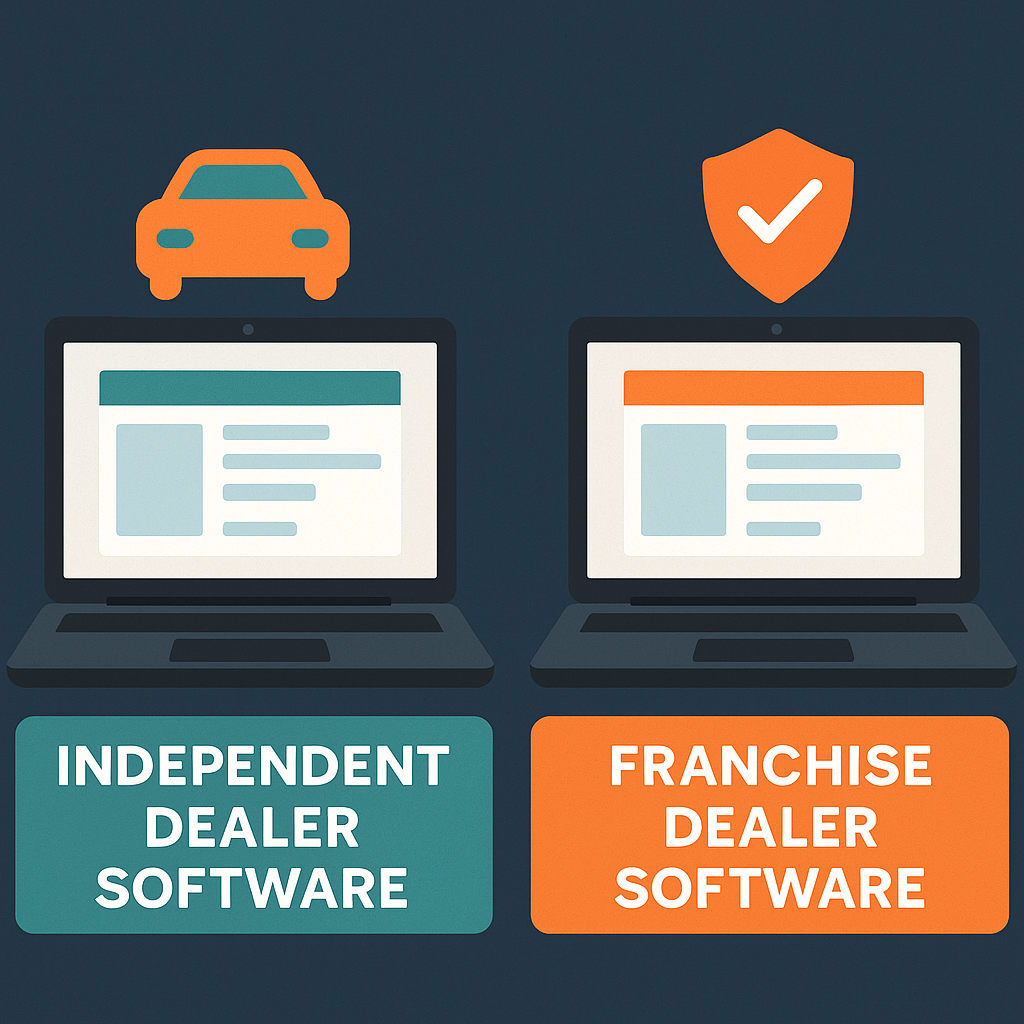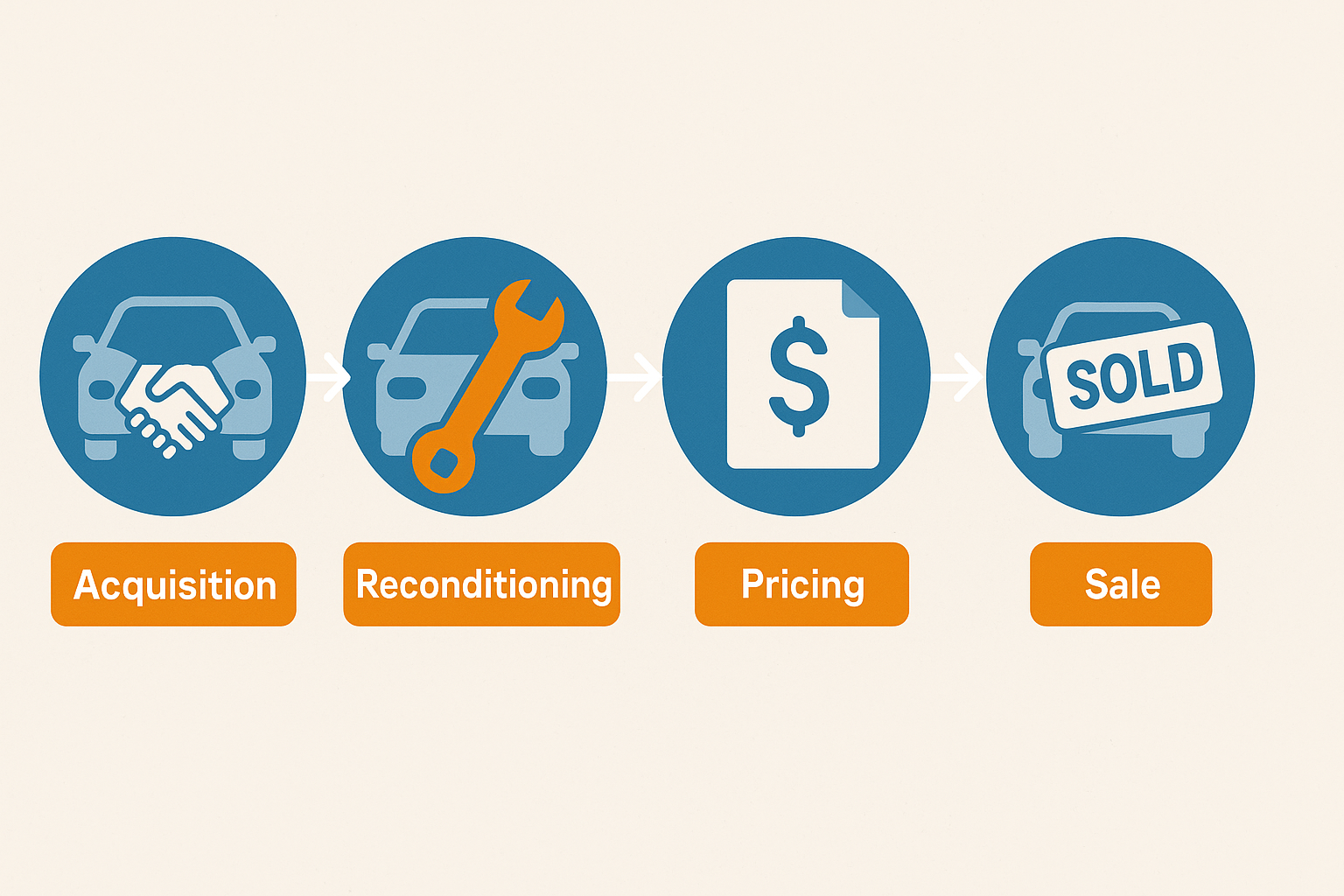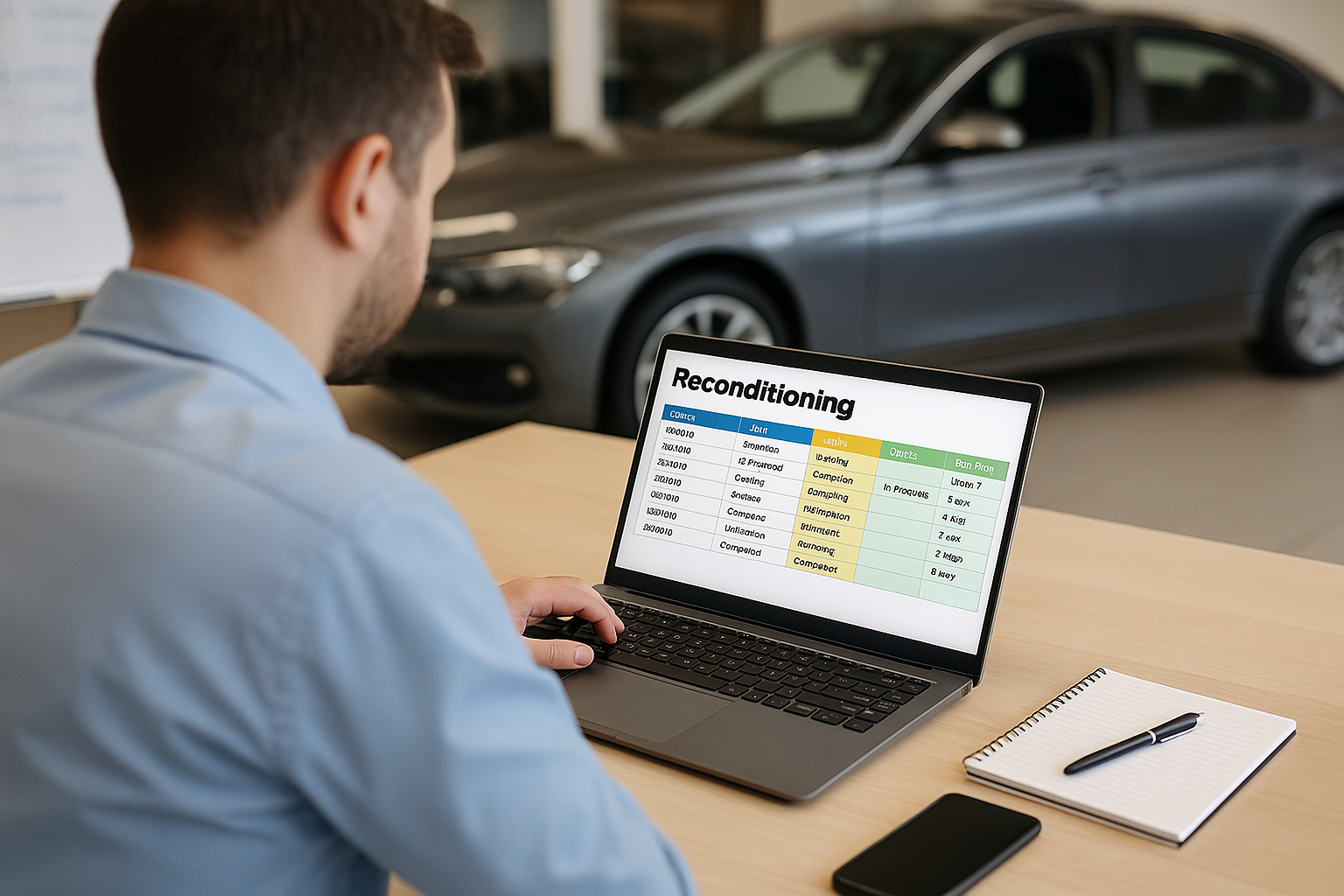For used-car dealers, Average Days on Lot (ADOL) is more than just a metric—it’s a profitability pulse. Every extra day a vehicle sits unsold represents carrying costs (lot space, financing, insurance) and the risk of depreciation, price drops, or obsolescence. According to industry estimates, holding costs can run $20–$50 per unit per day for used inventory. Keeping ADOL low is essential to protect margins and free up capital for new acquisitions.
Fortunately, modern dealership management software (DMS) and inventory analytics platforms give you the real-time visibility needed to proactively spot aging units, adjust pricing dynamically, and accelerate turn rates. In this post, we’ll dig deeper into how you can use reporting dashboards, automated alerts, and dynamic pricing tools—like those in the Carketa platform—to cut your ADOL in half.
1. Why Average Days on Lot Is a Dealership’s Profit Barometer
- Carrying Costs Add Up Fast Every day a car remains unsold, you incur costs for lot space, reconditioning, insurance, and financing. Multiply even a modest $30/day by a 60-day hold, and you’re looking at $1,800 in carrying expenses—just to break even on age.
- Depreciation Accelerates with Time A vehicle that sits 30 days longer typically loses an extra 0.5–1.5% of its value2, depending on market conditions and model demand. That can easily eat into your front-end gross and force deeper discounting.
- Inventory Turn Builds Momentum A lower ADOL frees up capital for fresh acquisitions, attracts bargain hunters drawn to “new-to-market” deals, and reduces the risk of stale inventory seeping into your pricing structure.
2. Leverage Real-Time Reporting Dashboards to Spot Aging Units
The first step to slashing ADOL is knowing exactly which units are at risk—and how fast they’re aging. Dashboards in modern software (e.g., Carketa’s Inventory Analytics) let you:
- Visualize Days-on-Lot Distribution
- A histogram view shows how many cars are at 0–10 days, 11–20 days, 21–30 days, and beyond. When you see a cluster of inventory in the “30+ days” bucket, you know immediate action is required.
- Filter by model, age, mileage, and even colour to spot patterns (e.g., “All silver sedans from 2016 have been on lot 45+ days.”).
- Rank Units by Aging Velocity
- A sortable “At-Risk” list orders your oldest vehicles from highest to lowest ADOL.
- Drill into each VIN’s history: acquisition date, reconditioning timelines, price changes, and current market comps.
- Benchmark Against Market Averages
- Integrated live market data (e.g., NADA, Manheim Market Report) shows you the average ADOL for comparable trims in your region. If your 2017 Honda CR-V is at 60 days while the market average is 30, you know it’s underperforming.
Action Step: Log into your dashboard daily and sort by “Days on Lot – Descending.” Identify the top 5 vehicles aged over 30 days and tag them for immediate review.
3. Set Up Automated Alerts to Flag Aging Inventory
Relying solely on manual dashboard checks can be a recipe for “out of sight, out of mind.” Instead, configure automated alerts so you never miss a unit slipping past your target ADOL threshold.
- Create ADOL Threshold Alerts
- Define a trigger: e.g., “Send alert when any unit hits 25 days on lot.”
- Alert methods can include:
- Email notifications to your inventory or sales manager.
- In-app push notifications (if your software supports a mobile app).
- Slack or Microsoft Teams integration for real-time team visibility.
- Segment Alerts by Profit Margin or Model Class
- For high-margin units (luxury SUVs, low-volume sports cars), set a tighter ADOL trigger (e.g., 15 days).
- For budget segment vehicles (compact sedans under $10 K), allow a slightly higher threshold (e.g., 30 days).
- Administer Weekly “At-Risk” Reports
- Generate a scheduled weekly summary that lists all vehicles crossing the ADOL threshold, grouped by department or sales rep.
- Assign accountability: each flagged unit is owned by a team member who must propose a pricing or marketing adjustment by week’s end.
Action Step: In your software’s “Alert Rules” section, configure a “30-Day ADOL” alert for all units. Assign the alert to your Inventory Manager so they receive a Slack message and email instantly when triggered.
4. Adjust Pricing Dynamically to Accelerate Turn Rates
Once you know which vehicles are aging, the next step is reactive and proactive pricing. Relying on static price tags forces you into reactive deep discounting. Instead, use dynamic pricing tools that automatically tweak asking prices based on competitive market changes and aging velocity.
- Implement Time-Based Price Drops
- Create a rule: after 14 days on lot, reduce price by 2%; after 21 days, reduce by 4%, and so on.
- Tie pricing rules to specific model segments (e.g., “All SUVs drop at 3% after 20 days”).
- Leverage Live Market Comparisons
- Software integrations pull real-time prices from local comps (e.g., “Your 2018 Toyota Camry is priced 2.5% above market average”).
- Auto-adjust pricing to stay within 1%–3% of local market median for similar mileage and trim.
- Factor in Reconditioning and Carry Costs
- If a unit has spent 10 days in reconditioning, automatically flag a “cost recapture” to maintain margin.
- For each day, calculate $X/day carrying cost and factor it into discount thresholds—so you never lose money by holding too long.
Action Step: Within Carketa’s “Pricing Intelligence” module, enable “Auto-Reprice” and set tiered markdown rules:
- Day 10–14: –1.5% if comps are within 5% lower.
- Day 15–20: –3% if comps are within 3% lower.
- Day 21+: Contact Sales Manager automatically for final markdown approval.
5. Use Predictive Analytics to Anticipate Aging Units Before They Hit the Lot
Rather than waiting for units to age, modern platforms can forecast which incoming inventory is likely to have higher ADOL—based on historical turn-time trends, seasonality, and local demand signals. Here’s how:
- Historical Turn Data Models
- Analyze past 12–24 months of sales by model, trim, and condition.
- Flag low-velocity categories (e.g., 2016 mid-sized sedans over 80K miles) before you buy.
- Seasonal Demand Indicators
- In many markets, convertibles and sports cars slow in fall and winter; SUVs and 4WD vehicles pick up.
- Integrate weather and local event data (e.g., “Winter in upstate NY boosts SUV demand by 8%”).
- Local Market Saturation Index
- Calculate how many similar units are currently on competitor lots within a 50-mile radius.
- Use a saturation score (1–10) to scale your target buy price (higher saturation = lower buy price to allow discount room).
Action Step: Before making weekend auction bids, review the “Projected ADOL” widget in your dashboard. Avoid any lot finds with a score > 7 (high saturation) unless you can aggressively reprice or market.
6. Monitor Key Metrics to Ensure Continuous Improvement
After implementing dashboards, alerts, and dynamic pricing, you need to measure progress and adjust rules. Track these KPIs each week:
- Average Days on Lot (ADOL) Trendline
- Plot weekly ADOL for the last 12 weeks.
- Aim to see a downward slope: e.g., from 45 days in January to 22 days by June.
- Inventory Turn Rate
- Calculate units sold divided by average inventory.
- A turn of 8–12 (i.e., selling 8–12x your average inventory per year) is a healthy benchmark for used lots.
- Gross per Unit (GPU) vs. Days Held
- Compare front-end gross on units sold under 15 days vs. 30+ days.
- If GPU drops more than $300 on units held past 20 days, tighten pricing rules.
- Markdown Frequency & Depth
- Track how often a unit hits its first markdown (Day 14, Day 21, etc.).
- If over 60% of your fleet requires markdowns, revisit acquisition criteria or adjust PDVs (price drop variance).
Action Step: Build a weekly scorecard in your dashboard showing ADOL, Turn Rate, GPU by age bucket, and markdown ratio. Review this at your Monday morning sales meeting to confirm targets are being met.
7. Actionable Steps to Cut Your ADOL in Half
- Audit Your Current ADOL
- Pull last 90 days of sales data and calculate your true ADOL. If it’s above 30 days, you have significant room for improvement.
- Enable and Customize Dashboards
- Identify your “Top 10 Aging Units” board and configure filters by segment and price. Make sure dashboards update in real time.
- Set Precise Alert Thresholds
- Establish a tiered alert system: 10 days (warning), 20 days (action), 30 days (escalation). Assign clear owners for each alert.
- Implement Tiered Dynamic Pricing
- Define markdown rules linked directly to ADOL stages. Use live market comps to guide percentages. Automate as much as possible to eliminate manual guesswork.
- Review and Optimize Weekly
- Schedule a 30-minute weekly meeting to evaluate ADOL trends, alert performance, and pricing outcomes. Tweak rules based on what moves best.
- Train Your Team on Compliance
- Ensure sales, appraisal, and recon teams know how to interpret dashboard signals and act quickly. Standardize “aging unit” workflows (e.g., 2-hour turnaround on markdown proposals).
8. Conclusion:
From Data to Dollars—Drive Profit with Proactive ADOL Management
In today’s fast-moving used vehicle market, standing still means falling behind. By leaning into real-time dashboards, automated alerts, and dynamic pricing, you can stop letting aging units drag down your lot, protect front-end gross, and reinvest capital into high-velocity inventory. Platforms like Carketa make it easy to tie live market data to your internal KPIs, so you can spot risk, act decisively, and keep your showroom full of fresh, in-demand vehicles.
Ready to halve your ADOL and boost turnover? Schedule a Carketa demo today to see how our inventory analytics and alerting tools help dealerships like yours turn inventory faster, preserve margins, and unlock new profit opportunities.





